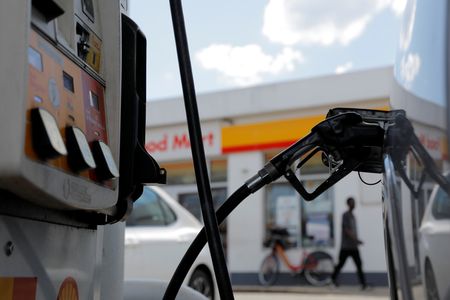By Lucia Mutikani
WASHINGTON (Reuters) – U.S. producer prices fell more than expected in May as the costs of energy goods and food declined, signaling that inflation pressures were abating throughout the economy and could eventually provide relief to consumers.
The report from the Labor Department on Wednesday also showed the annual increase in producer inflation last month was the smallest in nearly 2-1/2 years. Underlying producer prices were muted. It followed data on Tuesday showing consumer prices edging up in May, with the year-on-year rise the smallest since March 2021.
The Federal Reserve kept interest rates unchanged on Wednesday for the first time since March 2022 when the U.S. central bank embarked on its fastest monetary policy tightening campaign in more than 40 years.
The Fed, which has hiked its policy rate by 500 basis points in this tightening cycle, signaled in new economic projections that borrowing costs will likely rise by another half of a percentage point by the end of this year because of the economy’s resilience, particularly the labor market.
“There aren’t as many factory price increases in the pipeline waiting in ambush for consumers and that spells relief for the inflation-weary American public,” said Christopher Rupkey, chief economist at FWDBONDS in New York.
“Inflation isn’t finished wreaking its havoc on the economy yet, but we can see the day is coming when inflation will come down to more manageable levels after the pandemic demand surge completely dissipates.”
The producer price index for final demand dropped 0.3% last month after rising by an unrevised 0.2% in April. The PPI has now declined in three of the last five months. A 1.6% plunge in prices for goods, the largest decrease since last July, accounted for much of the drop in the PPI.
Goods prices, which rose 0.2% in April, were last month depressed by a 6.8% tumble in energy prices. Gasoline prices plummeted 13.8%, accounting for 60% of the decrease in goods prices. Food prices fell 1.3%, declining for a second straight month as eggs and vegetables cost less.
Food commodity prices have dropped back to levels seen prior to Russia’s invasion of Ukraine in February 2022.
The cost of services rose 0.2% after advancing 0.3% in April, driven by margins for automobiles and parts retailing. There were also increases in fuels and lubricants retailing as well as apparel, footwear and accessories retailing.
Fees for securities brokerage, dealing, investment advice and related services rose. But the cost of transporting freight by road fell 2.1% and portfolio management fees dropped 2.9%. Airline fare prices decreased 1.1%.
These services components feed into the calculation of the Personal Consumption Expenditures (PCE) price indexes, the inflation measures tracked by the Fed for its 2% target.
In the 12 months through May, the PPI climbed 1.1%. That was the smallest year-on-year rise since December 2020 and followed a 2.3% increase in April.
Inflation is subsiding as supply chain bottlenecks disappear and demand for goods slows in response to higher borrowing costs. Last year’s surge in prices is also dropping out of the calculation of annual inflation.
Economists polled by Reuters had forecast the PPI dipping 0.1% from the prior month and rising 1.5% on year.
ECONOMY RESILIENT
Stocks on Wall Street fell following the Fed’s rate decision and projections. The dollar pared losses against a basket of currencies. Shorter-dated U.S. Treasury yields rose.
Excluding the volatile food and energy components, the so-called core goods prices edged up 0.1% last month, matching April’s gain. This supports expectations that the economy could experience a period of consumer goods disinflation if not outright deflation. But some economists were skeptical.
“We will continue to watch core goods prices for signs that easing input costs could be passed on to lower prices, although this might be unlikely as consumers have become accustomed to higher price levels,” said Veronica Clark, an economist at Citigroup in New York.
The narrower measure of core PPI, which strips out food, energy and trade services components, was unchanged after inching up 0.1% in April. In the 12 months through May, the core PPI rose 2.8%, the smallest gain since February 2021, after increasing 3.3% in April.
With the CPI and PPI data in hand, economists estimated that the core PCE price index rose 0.3% in May after increasing 0.4% in April. The core PCE price index was forecast advancing 4.6% year-on-year in May after rising 4.7% in April.
The data will be published at the end of the month. Fed officials on Wednesday raised their core PCE inflation projection for this year to 3.9% from the 3.6% forecast in March.
“Inflation has moderated somewhat since the middle of last year,” Fed Chair Jerome Powell told reporters. “Nonetheless, inflation pressures continue to run high and the process of getting inflation back down to 2%.”
(Reporting By Lucia Mutikani; Editing by Chizu Nomiyama and Andrea Ricci)

